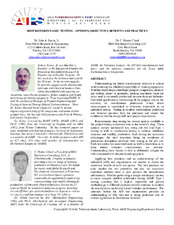| dc.contributor | Asia Turbomachinery & Pump Symposium (1st : 2016) | |
| dc.creator | Cloud, C. Hunter | |
| dc.creator | Kocur, John | |
| dc.date.accessioned | 2017-05-04T12:49:17Z | |
| dc.date.available | 2017-05-04T12:49:17Z | |
| dc.date.issued | 2016 | |
| dc.identifier.uri | https://hdl.handle.net/1969.1/160288 | |
| dc.description | Tutorial | en |
| dc.description.abstract | Tutorial 18: Understanding the lateral rotordynamic behavior is critical in determining the reliability/operability of rotating equipment. Whether examining a centrifugal pump or compressor, steam or gas turbine, motor or generator, rotating machinery share the same need to accurately predict and measure dynamic behavior. Industrial specifications determining fit for purpose rely on the accuracy of rotordynamic predictions where direct measurement is impractical or otherwise impossible in an industrial setting. Testing to confirm rotordynamic prediction and behavior provides both the purchaser and vendor the confidence that the design will meet project expectations. Rotordynamic shop testing has several options available to the project during acceptance tests at the vendor’s shop. These options include mechanical run, string and full load/Type 1 testing as well as verification testing to validate unbalance response and stability predictions. Such testing has numerous advantages; the most important being the avoidance of production disruptions involved with testing at the job site. Each test option has associated costs as well as limitations as to what lateral vibration characteristics are revealed. Understanding these factors is vital to efficiently mitigate the risks associated with the purchased equipment. Applying best practices and an understanding of the industrial (API) test requirements are needed to derive the maximum benefit of each test option. The best practices not only involve the test procedure but also the associated analytical methods used to post process the measurement information. Whether performing a simple mechanical run test or more complex stability verification during ASME Type I testing, ensuring that a logical, repeatable and proven methodology is followed produces reliable evidence to confirm the rotordynamic model and lateral vibration performance. The rationale behind the API test requirements provides an understanding of why that test is being performed and its correct application to the dynamic behavior. Test options can be separated into two categories; tests that reveal portions of the dynamic behavior of the equipment to specific operating conditions and those used to verify the analytical predictions of that behavior. API mechanical, string and Type I (or full load) tests reveal the rotordynamic behavior of the equipment to a given set of conditions. These are used specifically to determine acceptability of the design. Unbalance and stability verification testing is used to confirm (or provide confidence in) the rotordynamic model. Confidence in the model permits extrapolation of the design (vendor) and operation (purchaser) beyond the machine’s asbuilt and specific shop test conditions. | en |
| dc.format.medium | Electronic | en |
| dc.format.mimetype | application/pdf | |
| dc.language | en | |
| dc.publisher | Turbomachinery Laboratories, Texas A&M Engineering Experiment Station | |
| dc.relation.ispartof | Asia Turbomachinery & Pump Symposium. 2016 Proceedings. | en |
| dc.subject.lcsh | Turbomachines | en |
| dc.subject.lcsh | Pumping machinery | en |
| dc.title | Shop Rotordynamic Testing - Options, Objectives, Benefits & Practices | en |
| dc.type.material | Text | en |
| dc.identifier.doi | https://doi.org/10.21423/R1B12G | |


